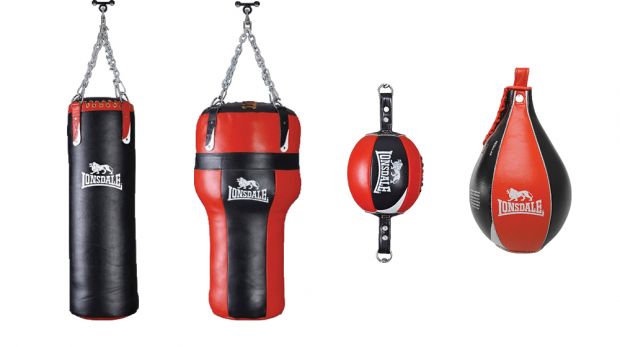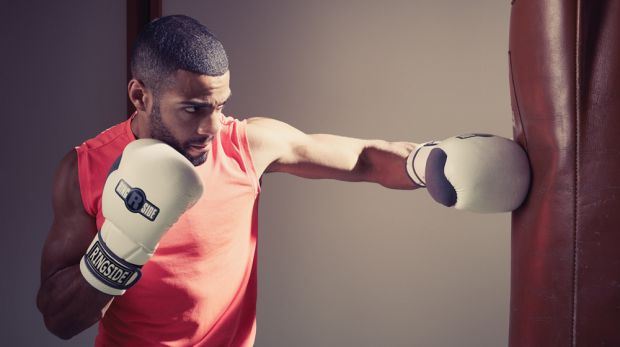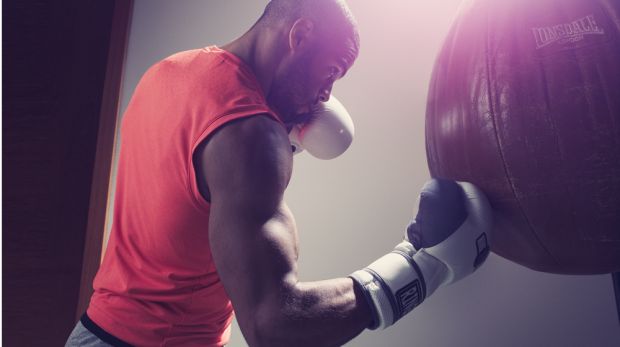Boxing Basics: How To Nail Punching-Bag Workouts At The Gym
Master the basics with our no-nonsense guide to learning boxing in the gym

Forget the TRX, the gymnastics rings, that weird machine you can’t quite work out how to wedge yourself into – the humble punchbag, dangling there largely unused, is the most intimidating bit of kit in any modern gym. Sure, you could just go over and give it a thump – everyone has at least a vague idea of how to do that, surely – but what if you miss? Hit it wrong? Do some other thing known only to gravel-voiced old-school trainers that marks you out as a bum?
First, you need to get over this. “Boxing is a perfect form of high-intensity training, with well-documented benefits that include fat loss and VO2 max improvements,” says Gideon Remfry, head trainer at London’s KX Gym. “It’ll also help to improve your ability to deal with lactate build-up, as well as improving your insulin resistance – helpful if you’re trying to lose weight.”
Second, don’t fret. We’ve assembled all the expert information you need to go from pretender to contender in a few short sessions using nothing more than the bag. Glove up, and get ready for round one.
When you're ready, head over to our punching-bag workouts to smash out at the gym.
Master the Basics
The Footwork
Don’t just plant and throw. Pros move around the bag to mimic a fight – for you, it’ll improve calf strength and cardio. Learn this before you throw a punch, and you’ll look like a champ when it’s time to glove up
Ropework: There’s a reason boxers skip. “It’ll improve your calf endurance and ability to spend time on your toes,” says Carlos Andrade, boxing coach at KX Gym and former European kickboxing champ. “And it’ll improve your overall fitness.” Start your with three one-minute rounds, resting for 30 seconds in between – research suggests it’ll fire up your nervous system, making your punches harder.
The Stance: “Plant your feet in a boxing stance – one forward, one back,” says Andrade. “Move forward by pushing off your back foot and move back by pushing off your front foot – for circular movements, push off the foot opposite the direction you’re going. Your bodyweight should be evenly distributed and only 10% should be transferred from back foot to front foot at any given time.” Small, shuffling steps are key, and don’t cross your feet – it marks you out as an easily-overbalanced amateur.
Get the Coach Newsletter
Sign up for workout ideas, training advice, reviews of the latest gear and more.
Stick and Move: Now it’s time to put it together. Start moving as you punch – take a step forward as you’re on offence, then circle out to one side after you throw a combination. Instead of steadying the bag between shots, work on moving towards or away from it, maintaining distance as it swings.
RECOMMENDED: Carl Froch’s Boxing Training Routine
Move Your Head
Even if you aren’t going to get punched back, get into the habit – it’ll work your core, build good habits and make you look like you know what you’re doing. Here’s how it’s done
Look in the mirror: “Draw a vertical line on a mirror with chalk or soap,” says Andrade. “Now get into your stance with the line in the centre of your body. Now move your head from side to side, slightly up and down, so that your head’s never on one side of the line for more than a second.” Do five one-minute rounds.
Duck the rope: Tie a skipping rope (or set of handwraps) across the ring or gym at roughly head height, then move forwards and backwards along the rope, ducking underneath it. A couple of two-minute rounds before your session will build good habits.
Put it together: “Always keep your head moving when on the bag,” says Andrade. “Make a point of moving your head so that it’s never in the same place for more than a second.” Keep it short and economical, and imagine you’re slipping real punches as they come back – it’ll add realism and make your workout more intense.
Glove Up

What size do you need? “Historically, boxers doing bag work have used 4oz or 6oz bag gloves, also referred to as mitts,” says Andrade. “However, over the last decade or so, the 10oz boxing glove has become more popular for hitting both the bag and the pads. It generally feels better when you make contact with the target. You’re also able to use hand wraps which makes the hand feel more protected when hitting the bag, which in turn produces a harder punch, increasing your work rate.” Thinking about sparring? You’ll need a 16oz set to protect your opponent’s head – not to mention your hands.
How to wrap your hands: It’ll protect your metacarpals and let you punch harder
- First, put the loop around your thumb, then wrap around and behind your hand, then three times around your wrist.
- Next, wrap across the back of your hand three times, going straight across from the gap between your thumb and fingers to the blade of your hand.
- Now you’re going to make three Xs around your fingers, starting with the pinkie and moving to the index finger.
- Now loop the wraps around your thumb – this’ll lock it in place and reduce the chances of you jamming it on the bag with a misplaced punch.
- Finally, use any extra material to wrap around your knuckles, then finish by Velcroing the wraps into place at your wrist.
Which Bag Is Best?

Left to right: heavy bag, uppercut bag, double-end bag, speedbag
Pick the right one for the job in hand The standard heavy bag is useful for most aspects of boxing training – but go to a fighter-friendly gym and you’ll find a few other options. Here’s how to get the most out of them
Heavy bag: The most common bag – ideal for practising straight punches and hooks at head height. It’ll also have a slight natural swing, letting you move around it.
Uppercut bag: Either a ball or a top-heavy bag will work for practising body shots and uppercuts. Work your angles, and make sure you’re digging into it with every punch.
Double-end bag: This is a ball with ropes attaching it to the floor and ceiling – use it to practise “slipping” (dodging punches) and accuracy, and try not to let it hit you in the face.
Speedbag: Fulfil your Rocky fantasies by hitting it with the base of your hand and moving your fist in a circle. Let it rebound three times before your next shot. Start slow, and build speed.
The Punches
Master the big four punches, learn the combinations and impress with some show-off shots

1 The Jab
Your quickest punch comes from your lead hand and should dent the bag. “Always throw the jab from chin height and return to the same position,” says Andrade. “As you throw it, dip your head slightly, keeping your chin tucked in so that any oncoming punches miss your head.” As you get more confident, try to string together two or three jabs.
Upgrade to the jolt: To throw this harder version, take a step forward with your lead foot as you throw, dropping your bodyweight slightly to take your head off your centre line.
2 The Cross
This comes from your rear hand - if you’re standing with your left foot forward, drive off your right foot and rotate your right hip and shoulder forward, and throw your right hand out, turning it palm-down at the end of the motion. “Your arm should travel in a straight line across your body at chin height,” says Andrade. “Keep your back foot in contact with the ground, twisting it as if crushing a cigarette.”
Upgrade to the 1-2: It’s the classic combination for a reason. After a jab, your hips are twisted in the right direction to unload with the cross. Throw a jolt or two, then switch back to a quicker, more upright jab and immediately follow up with a right cross. For extra style points, bob and weave out to your right: most opponents will follow up with a left hook counter.
3 The Hook
You’ll normally throw these with your lead hand – rear hand hooks are trickier. “Bring your elbow up to face height and rotate your entire body in the direction the punch goes,” says Andrade. “Some people throw the hook with a horizontal fist and others with a vertical fist. There is no right or wrong way.” Keep your elbow bent at 90˚.
Upgrade to the Russian hook: To throw a hook at long range, turn your fist further over and bend your elbow less. Russian fighters are known for throwing hooks with their thumbs pointed down and arms almost straight.
4 The Uppercut
The trickiest punch to master, but the nastiest when it lands. “It’s usually delivered to the lower part of the jaw and will require you to bend your knees and tilt your body to the left or right depending on which hand you use,” says Andrade. “When the punch is travelling up, keep your elbow close to you until the very last moment, then raise your heel – keep the ball of your foot on the ground – and thrust your hip in the same direction.” Ideally, practise on a curved bag.
Upgrade to the Dempsey roll: Invented by American heavyweight Jack Dempsey and used by Mike Tyson. Keep both hands close to your chin and your elbows tucked to your sides, then weave your body in a figure eight in front of the bag. Once you’ve mastered the movement, add uppercuts at the “bend” of the move.
RECOMMENDED: How to Punch Like an MMA Fighter

The Combinations
Think of it as boxing by numbers – pro trainers will call out numerical combos on the bag or in the ring. Start with these three, then develop your own
1-2-3: Simple, timeless, classic: each shot loads you up for the next one, increasing your power. To make it more effective, experiment with throwing the cross as a body shot – a real opponent would have to defend on two levels. For a four-punch combination, add a second cross after the hook.
1-3: Throwing two punches off the same hand takes co-ordination, but it’s worth practising: even if an opponent defends the jab, his hand will be out of position, letting you sneak the hook round to catch him on the chin.
2-3-2: Your power combination. Tricky to land without a set-up, but a solid option for building power on the bag. In a real fight, you’d aim to land it against a southpaw – stepping outside their lead foot leaves them unable to hit you while you fire the first straight.
The Show-Off Shots
Ready to graduate beyond the big four? These are the next moves to add to your arsenal
A good one will crumple your opponent. “This is my favourite shot,” says Andrade. “The delivery is similar to that of an uppercut except you’re targeting the ribs or the midsection.” Dig it into the bag, making sure you’re twisting. For best results, throw it after a 1-2 – a real opponent would cover up to avoid the headshots, leaving his ribs exposed.
Especially popular in MMA, where the smaller gloves mean it’s easier to sneak through an opponent’s defence. It also lands from above, which is the last thing he’ll be expecting. Swing your power hand like you’re bowling a cricket ball, dropping your body as you throw for more power and aiming to connect with your top two knuckles.
“The sneaky punch,” says Andrade. “It’s also known as an ‘up jab’, and it’s a hybrid punch – half uppercut, half jab – which makes it hard to block or evade. It’s thrown like a jab but with the knuckle part of the glove facing down, travelling in a upward corkscrew motion from the lower part of your chin up to your opponent’s head. It’s not a knockout punch but it can confuse an opponent by slicing right through the middle of his guard.”
Ready to smash out a boxing workout? Give these punching-bag workouts a try at the gym.
From 2008 to 2018, Joel worked for Men's Fitness, which predated, and then shared a website with, Coach. Though he spent years running the hills of Bath, he’s since ditched his trainers for a succession of Converse high-tops, since they’re better suited to his love of pulling vans, lifting cars, and hefting logs in a succession of strongman competitions.










